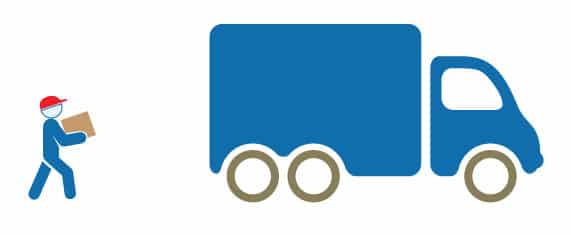Ecommerce is hotter than it’s ever been. With companies in many industries struggling to survive, eCommerce may provide an alternative to managing a brick-and-mortar storefront. We’ve talked before about how to set up an eCommerce store for the first time, but this week, we want to talk about how to retain eCommerce customers.
In order to succeed in business, the amount of money you receive from each customer needs to be significantly greater than the amount you spend to acquire a new customer. In other words, customer lifetime value (LTV) needs to be much greater than customer acquisition cost (CAC). You can do this in one of two ways: sell more expensive items or sell more items to existing customers. We’re going to talk about the latter.
Retaining eCommerce customers has a number of business benefits. Selling to existing customers is cheaper since they already know your store exists. On top of that, it’s far easier to sell to existing customers. According to ActiveCampaign, the odds of selling to an existing customer are 60-70%. That’s much greater than the odds of selling to a new prospect, which range from 5-20%.
At the same time, customer retention in eCommerce can be tricky. When selling online, it’s easy for items to be treated as commodities, meaning customers may not remember who the sellers are. Fortunately, there are ways to work around this which we discuss further below.
1. Focus on branding your business.
One of the biggest issues that eCommerce store owners face is simply being forgotten about. When people buy online through marketplaces like Amazon or eBay, sellers don’t have much of a chance to make an impression.
You can fight back by focusing on developing a solid brand. By having a consistent brand style – logo, colors, fonts, packaging, and so on – you increase the chances that customers will spontaneously remember your brand. This is called brand recall, and it can sometimes prompt customers to look you up on their own with no prompting.
2. Think about the entire customer lifecycle.
Many businesses focus solely on getting initial sales. However, this does not necessarily lead to long-term client relationships. For this reason, it helps to think about the customer lifecycle in terms of five key steps:
- Initial reach: this is the first time a potential customer hears about your brand.
- Acquisition: the first sale.
- Development and nurturing: after making the initial sale, your business starts forming a relationship with the customer. Make sure they are satisfied with their purchase and start anticipating future needs.
- Retention: upon determining probable future needs, convince the customer to buy once more.
- Advocacy: convince the customer to spread the word of your brand.
It’s easy to focus on just steps one and two, but in order to retain and acquire more customers, you need to understand all five.
3. Track customer behavior.
Based on the lifecycle described above, the key to customer retention is anticipating future needs. You can do this by analyzing a customer’s buying habits and sending targeted sales pitches at the right time. For example, if you buy a desk on Wayfair, they will likely wait a week or two before sending you an email with special offers on office chairs.
4. Personalize the customer experience.
Have you noticed how when you log onto Amazon it uses your shopping history to predict your needs? You can do something similar with your own store. By using data gathered via form submissions, email software, web analytics, or past purchases, you can make personalized recommendations to users, thereby increasing their odds of buying from you.
5. Allow guest checkout.

Failure to allow guest checkouts causes people to abandon your site without buying. If you wisely choose to allow guest checkouts, that means many of your loyal customers won’t actually create accounts. They will instead continue to use the guest checkout. For this reason, allowing guest checkouts doesn’t just make it easier to acquire customers, but it makes it easier to retain them as well.
6. Implement a loyalty program.
There is a reason why airlines use analyzing a customer’s buying habits. It’s hard to justify using any airline but Delta if you have racked up a hundred thousand SkyMiles. You can apply this same basic concept your business as well.
7. Give out freebies and coupons.
It’s an old trick, but still very effective. Sometimes all people need to make the decision to complete a purchase is a little push. A coupon that discounts an item for a limited time or a freebie given away upon purchase may just be the push your on-the-fence repeat customers may need to buy again.
8. Cross-sell.
Cross-selling is when you invite customers to buy related items. For example, if a customer buys a laptop from you, you can cross-sell them a wireless mouse, headphones, and spare charging cable. Business 2 Community suggests cross-selling in tandem with a bonus such as a discount code as a way of increasing customer retention.
9. Use email marketing.
Email marketing has repeatedly been shown to be one of the most cost-effective forms of digital marketing. This is for a few reasons. First, people who sign up for your mailing list are likely to be very interested in what you’re selling. Next, you can use open and click rate data to analyze what customers want so you can make customized offers.
This can get complicated, so if you’d like more tips, check out this guide by HubSpot on email marketing. It’s a long read, but worth it.
10. Use content and social media marketing.
One way to really set your business apart by others is through clever use of content and social media marketing. This is because well-made content provides value for anyone who consumes it. It’s time-consuming to create, but it makes people respect and remember your brand.
Social media is an extension of older forms of content marketing like blogging and video because it allows you to interact directly with people. You can use social media to engage with new and existing customers by sharing content, making special offers, or simply by being conversational.
11. Use unique packaging.

We’ve talked about the importance of quality packaging before, but the point is so important that it bears repeating. People will forget about your business unless you give them a reason not to. Pretty packaging can make a big difference in whether or not they forget about your business.
12. Provide excellent customer support.
When customers reach out to you with a problem, there are two basic ways the conversation can unfold. Nobody wants to contact customer service, so they’re already in a bad mood. If you fail to adequately address their problem, they may abandon your brand. However, if you do solve their problem, they will regard your brand as being a good one that cares, and may be more likely to purchase from you in the future.
13. Implement a referral program.
Referral programs are often thought of as a way of acquiring new customers. However, they also have the side benefit of retaining existing ones as well. Think about it: anyone who is given an incentive to refer new people to your business is more likely to think of your brand in a positive way.
14. Provide generous return and delivery options.
Stingy return policies and slow deliveries make people less likely to purchase from your business again. Either one is a bad experience, so avoiding these pitfalls can help you to retain customers and make more money.
If you have trouble managing returns or shipping quickly, consider outsourcing fulfillment. It can make a noticeable difference in the quality of your service and sometimes even saves money too.
15. Consider a subscription-based business model.

While it isn’t appropriate for every kind of business, a subscription-based service automatically builds customer retention into its business model. It may be harder to acquire customers at first since selling someone a subscription requires convincing. However, once customers are onboarded, your business can make steady money.
16. Consider a repurchase/replenish-based model.
If you sell something consumable or disposable like coffee or plastic shaving razors, you can give customers the ability to automatically repurchase or replenish their supplies after a certain amount of time. This has many of the same benefits of a subscription-based model, but can be applied to different industries.
17. Exceed customer expectations.
Ultimately, retaining customers comes down to giving people good impressions of your company. Often the best way to do that is to simply be excellent at what you do. That is to say, provide great products and great customer service. Do what you do better than anyone else.
Final Thoughts
Focusing on improving customer retention can do wonders for your eCommerce business. Many eCommerce stores have an easy time acquiring customers, but a hard time being remembered afterward. By focusing on customer retention, you can make more money from the same customers and your business will be in a much better place to survive and thrive.
Amount of money you receive from each customer needs to be significantly greater than the amount you spend to acquire a new customer. The customer lifetime value (LTV) needs to be much greater than customer acquisition cost (CAC). While you can do this by seller more expensive items, it is easier to do so by selling more items to existing customers.
You’ve done everything by the book. Your Kickstarter campaign is almost ready to launch.
You made a great product. Built an audience. Set up a campaign page.
But how do you ship it?
We put this checklist together to help you get started. It's free.





